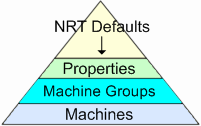<< BO Online Help >>
MONITORING
MAINTENANCE
REMOTE ADMINISTRATION
REPORT
VIEW
HELP

DATE: 2025-10-30 TIME: 13:06:19
MAINTENANCE / SYSTEM PARAMETER
| This help file covers the following topics: | |
|
|
An administrator (with proper authority) can create a new NRT Default parameter. This parameter is written to the SQL Server database and is inherited by all properties and machines which share this database.

There is a hierarchy within BackOffice.
This hierarchy might best be displayed as
a triangle,
with "NRT Defaults" at the top, "Properties" next, and then Machine Groups and "Machines" at the bottom.
A property inherits the "NRT Defaults", unless it overrides a param value with a property parameter.
A machine group inherits the "Property" parameters, unless it overrides a param value with a machine group parameter.
A machine inherits the "machine group" parameters, unless it overrides a param value with a machine parameter.
| Notes: | 1. | The NRT default parameters are configured by an NRT administrator and cannot be changed. | |
| 2. | An administrator, with proper authority, can add new NRT default parameters. (read more) | ||
| 3. | At the machine level you are limited to overriding existing parameters selected from a list. |
The page allows you to add a new NRT default parameter, which will be inherited by all properties and machines which share the SAME database.

| 1. Parameter ID | Enter parameter ID. (cannot duplicate an existing parameter ID) |
| 2. Parameter Data | Click the edit parameter data button to enter the parameter data. |
| 3. Comments | Enter comments. (describe parameter, what it does, and possible values) |
| 4. Parameter Group | Select a parameter group from the list. |
| 5. + Param Editor | Param editor not available when adding a parameter. (see notes below) |
| Click edit parameter data button to enter the parameter data into a textbox. |
| Notes: | 1. | A new parameter is updated on machines immediately, so no option to wait for scheduled update. | |
| 2. | + Parameter editor not available for a new parameter, only the textbox entry of parameter data. |
An administrator, with proper authority, can add a new parameter using BackOffice. This new parameter will be added to the NRT default parameters. This parameter will be inherited by all properties which utilize the same SQL Server database. This new parameter cannot be deleted from within BackOffice.